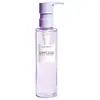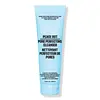What's inside
What's inside
 Key Ingredients
Key Ingredients

 Benefits
Benefits

 Concerns
Concerns

 Ingredients Side-by-side
Ingredients Side-by-side

Water
Skin ConditioningDecyl Glucoside
CleansingCaulerpa Lentillifera Extract
Beta-Glucan
Skin ConditioningSodium Hyaluronate
HumectantVaccinium Angustifolium Fruit
AstringentGlycolic Acid
BufferingLactic Acid
BufferingPhysalis Peruviana Fruit Extract
Skin ConditioningRubus Idaeus Fruit
AstringentArctostaphylos Uva-Ursi Leaf Extract
Skin ConditioningMorus Nigra Fruit Extract
Skin ConditioningVaccinium Myrtillus Fruit Extract
Skin ConditioningScutellaria Baicalensis Root Extract
AstringentPaeonia Suffruticosa Root Extract
Skin ProtectingGlycyrrhiza Glabra Root Extract
BleachingBetaine
HumectantSodium Chloride
MaskingGlycerin
Humectant1,2-Hexanediol
Skin ConditioningButylene Glycol
HumectantParfum
MaskingWater, Decyl Glucoside, Caulerpa Lentillifera Extract, Beta-Glucan, Sodium Hyaluronate, Vaccinium Angustifolium Fruit, Glycolic Acid, Lactic Acid, Physalis Peruviana Fruit Extract, Rubus Idaeus Fruit, Arctostaphylos Uva-Ursi Leaf Extract, Morus Nigra Fruit Extract, Vaccinium Myrtillus Fruit Extract, Scutellaria Baicalensis Root Extract, Paeonia Suffruticosa Root Extract, Glycyrrhiza Glabra Root Extract, Betaine, Sodium Chloride, Glycerin, 1,2-Hexanediol, Butylene Glycol, Parfum
Water
Skin ConditioningSodium Cocoyl Isethionate
CleansingPropanediol
SolventCocamidopropyl Betaine
CleansingMyristic Acid
CleansingDiglycerin
HumectantStearic Acid
CleansingCellulose Acetate
Caprylic/Capric Triglyceride
MaskingAmmonium Acryloyldimethyltaurate/Vp Copolymer
Zea Mays Starch
AbsorbentSodium Lauroyl Methyl Isethionate
CleansingCaprylyl Glycol
EmollientGlyceryl Caprylate
EmollientSodium Methyl Oleoyl Taurate
CleansingCocamidopropyl Dimethylamine
EmulsifyingCoconut Acid
CleansingEthylhexylglycerin
Skin ConditioningBetaine
HumectantNiacinamide
SmoothingGlyceryl Dibehenate
EmollientPotassium Hydroxide
BufferingSalicylic Acid
MaskingCoco-Glucoside
CleansingLauryl Glucoside
CleansingTribehenin
EmollientSodium Isethionate
CleansingSodium PCA
HumectantGlyceryl Behenate
EmollientPalmitic Acid
EmollientSodium Lactate
BufferingPCA
HumectantSodium Benzoate
MaskingLauric Acid
CleansingSerine
MaskingAlanine
MaskingGlycine
BufferingSodium Hyaluronate
HumectantGlutamic Acid
HumectantLysine Hcl
Skin ConditioningThreonine
Arginine
MaskingProline
Skin ConditioningAlcohol
AntimicrobialCitric Acid
BufferingSodium Carboxymethyl Starch
Emulsion StabilisingSodium Chloride
MaskingSodium Citrate
BufferingWater, Sodium Cocoyl Isethionate, Propanediol, Cocamidopropyl Betaine, Myristic Acid, Diglycerin, Stearic Acid, Cellulose Acetate, Caprylic/Capric Triglyceride, Ammonium Acryloyldimethyltaurate/Vp Copolymer, Zea Mays Starch, Sodium Lauroyl Methyl Isethionate, Caprylyl Glycol, Glyceryl Caprylate, Sodium Methyl Oleoyl Taurate, Cocamidopropyl Dimethylamine, Coconut Acid, Ethylhexylglycerin, Betaine, Niacinamide, Glyceryl Dibehenate, Potassium Hydroxide, Salicylic Acid, Coco-Glucoside, Lauryl Glucoside, Tribehenin, Sodium Isethionate, Sodium PCA, Glyceryl Behenate, Palmitic Acid, Sodium Lactate, PCA, Sodium Benzoate, Lauric Acid, Serine, Alanine, Glycine, Sodium Hyaluronate, Glutamic Acid, Lysine Hcl, Threonine, Arginine, Proline, Alcohol, Citric Acid, Sodium Carboxymethyl Starch, Sodium Chloride, Sodium Citrate
 Reviews
Reviews

Ingredients Explained
These ingredients are found in both products.
Ingredients higher up in an ingredient list are typically present in a larger amount.
Betaine is a common humectant (a substance that promotes retention of moisture). It's known to be gentle on the skin and can help balance hydration.
This ingredient is best for improving hydration and soothing irritated skin. Studies also show it helps even out skin tone.
Fun fact: Betaine is naturally created in the skin and body. The kind found within cosmetic products can be either plant-derived or synthetic.
Another name for betaine is trimethylglycine.
Learn more about BetaineChances are, you eat sodium chloride every day. Sodium Chloride is also known as table salt.
This ingredient has many purposes in skincare: thickener, emulsifier, and exfoliator.
You'll most likely find this ingredient in cleansers where it is used to create a gel-like texture. As an emulsifier, it also prevents ingredients from separating.
There is much debate on whether this ingredient is comedogenic. The short answer - comedogenic ratings don't tell the whole story. Learn more about comegodenic ratings here.
The concensus about this ingredient causing acne seems to be divided. Research is needed to understand if this ingredient does cause acne.
Scrubs may use salt as the primary exfoliating ingredient.
Learn more about Sodium ChlorideSodium Hyaluronate is hyaluronic acid's salt form. It is commonly derived from the sodium salt of hyaluronic acid.
Like hyaluronic acid, it is great at holding water and acts as a humectant. This makes it a great skin hydrating ingredient.
Sodium Hyaluronate is naturally occurring in our bodies and is mostly found in eye fluid and joints.
These are some other common types of Hyaluronic Acid:
Learn more about Sodium HyaluronateWater. It's the most common cosmetic ingredient of all. You'll usually see it at the top of ingredient lists, meaning that it makes up the largest part of the product.
So why is it so popular? Water most often acts as a solvent - this means that it helps dissolve other ingredients into the formulation.
You'll also recognize water as that liquid we all need to stay alive. If you see this, drink a glass of water. Stay hydrated!
Learn more about Water